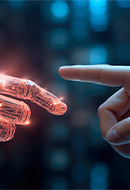AI Algorithms
Types of Artificial Intelligence Algorithms
Exploring the fascinating world of artificial intelligence requires, above all, delving into the diversity of its algorithms. From supervised learning, which serves as the basis for recommendation systems, to reinforcement learning – used to improve the response of dialogue systems such as chatbots. Discover the types of algorithms that AI uses to transform our technological environment.

Algorithms are a constant presence in our day-to-day lives. They are responsible for optimising our experiences in daily tasks such as searching for content on social networks, or consulting a chatbot programmed to respond immediately to our requests. But to fully understand how they work, it is necessary to do more research on artificial intelligence and learn about the different types of AI algorithms.
As many already know, AI applications aim to train machines so that they can operate autonomously with the same skills as a human being. But what few know is how this system works: it is all about a combination of algorithms that together are able to perform multiple activities quickly and efficiently. Based on machine learning, these algorithms are a series of steps that must be followed in a certain order to accomplish a task.
Among these tasks, we can find: faster medical diagnoses for the early detection of a disease, personalised purchase suggestions on digital platforms, virtual assistants such as Alexa or Siri and even simultaneous translations. Artificial intelligence algorithms play a key role for digital transformation – providing a wide range of applications that make our daily lives easier, and having, on top of that, an incredible ability to analyse large volumes of data and detect similarities that could go unnoticed by the human eye.
These advances in artificial intelligence – a concept with an almost century-old history – are transforming our interaction with technology and redefining the way we work, interact or enjoy our leisure time. However, for these powerful tools to be effective, we need to know their true capabilities. Below we will explain the different types of learning algorithms in artificial intelligence.
Reinforcement Learning Algorithms
Reinforcement learning algorithms represent a technique that focuses on the decision-making based on one's own experience. Instead of relying on labelled data, like other types of algorithms, this category is based on a trial-and-error training process, in which the machine receives rewards or punishments that serve to improve its action strategy. In this sense, here are some examples:
![]() Autonomous robotics
Autonomous robotics
Autonomous robots use reinforcement learning algorithms to learn to navigate in unfamiliar environments, manipulate objects and perform complex tasks.
![]() Resource management and planning
Resource management and planning
These algorithms are also widely applied in environments such as traffic guidance, financial portfolio optimisation and energy management, with the aim of maximising efficiency and resources.
![]() Virtual assistants
Virtual assistants
Algorithms are applied in virtual assistants and chatbots to understand user preferences and provide more personalised responses, as well as in the automation of customer service or technical support tasks.
![]() Computer vision
Computer vision
Algorithms are essential in facial recognition, motion tracking and image analysis, which is used in applications embedded in security systems or self-driving vehicles.
![]() Medical diagnostics
Medical diagnostics
Algorithms assist healthcare professionals in the identification of diseases through the analysis of medical images such as X-rays and MRI scans.
Discover the benefits of Artificial Intelligence Algorithms
-
Efficient automation
Algorithms enable the automation of repetitive and complex tasks, improving operational efficiency and freeing up time for more strategic work.
-
Security and anomaly detection
Algorithms contribute to the security of digital systems by identifying anomalous patterns or detecting cybersecurity threats.
-
Personalisation and recommendations
Algorithms enable personalised user experiences on streaming platforms and targeted advertising, improving user satisfaction.
-
Better user experience
In customer service apps, algorithms anticipate users' needs by providing faster and more personalised responses.
-
Development of new solutions
Algorithms drive innovation by enabling the development of advanced technological solutions, from self-driving vehicles to virtual assistants.
-
Accuracy and speed in predictions
Algorithms improve the accuracy of tasks such as medical diagnoses, weather forecasts and financial risk analysis.
 SEE INFOGRAPHIC: Discover the benefits of Artificial Intelligence Algorithms [PDF]
SEE INFOGRAPHIC: Discover the benefits of Artificial Intelligence Algorithms [PDF]
Supervised Learning Algorithms
This type of algorithm uses a set of training data that has been previously labelled, i.e. data that has been assigned one or more categories to add context or meaning. In the field of machine learning, this data serves as a basis for making predictions or more accurate decisions about new data not included in the trained set.
The main goal of Supervised Learning algorithms is to learn a function or model capable of accurately mapping inputs to desired outputs. This technique is used in a wide range of applications. The following are the best known:
 Text and natural language classification
Text and natural language classification
Supervised learning algorithms are used in natural language processing applications such as spam filtering and sentiment analysis in social networks.
 Recommendation system
Recommendation system
These algorithms are applied in streaming or e-commerce platforms to make content recommendations, suggesting products, movies or music based on the user's history and preferences.
Unsupervised Learning Algorithms
Unsupervised learning algorithms are used to discover hidden patterns in unlabelled data. Supervised Learning algorithms have prior knowledge of the desired answers – whereas Unsupervised Learning algorithms do not have an ordered dataset. They determine by themselves which are the most important common features of a dataset and then group them according to their similarities.
These algorithms can identify audience segments with similar interests and have a wide range of applications. For example:
 Clustering
Clustering
Algorithms are used to group similar data into clusters, which is essential for market segmentation analysis and news categorisation.
 Anomaly detection
Anomaly detection
Unsupervised learning algorithms are useful in detecting unusual behaviour or anomalies in data, which is applied in cyber security and financial fraud.

Green artificial intelligence
Green AI has emerged as one of the main mitigation pathways.
-R. San Juan Moya-

What is AI?
Are we aware of the challenges and main applications of AI?

History of artificial intelligence
Discover its history and how we at Iberdrola are taking advantage of this technology.

Evolution of Artificial Intelligence
Find out how AI has evolved over the years.
Deep Learning Algorithms
Deep Learning is a specialised branch of artificial intelligence that focuses on the construction and training of deep neural networks. These networks – inspired by the structure and function of the human brain – are structured as layers of interconnected nodes; each performing complex mathematical operations. In contrast to more traditional models, deep neural networks are capable of learning hierarchical representations and abstractions of data, which makes them exceptionally effective for tasks such as pattern recognition, natural language processing, computer vision, etc.
Deep Learning algorithms have a multitude of applications, with an important role in fields where computer vision, virtual assistants and chatbots are used. In the field of robotics, it facilitates autonomous learning to improve the ability to navigate, manipulate targets and adapt to changing environments. In business, predictive analytics models complex patterns to predict future events, such as market trends and consumer behaviour. Its ability to analyse big data helps strategic decision-making in fields such as finance and logistics.
Natural Language Processing (NLP) Algorithms
Natural Language Processing (NLP) algorithms are a specialised category of artificial intelligence algorithms designed to understand and process human language efficiently. They have the ability to enable machines to interpret, analyse and generate text in a manner similar to that of a human being, which allows a more natural communication between humans and machines. Today, this field of computer science has a multitude of applications such as:
 Sentiment analysis
Sentiment analysis
They assess the emotional tone of texts, comments or reviews, which is important information for companies wanting to understand the public's perception of products or services.
 Document classification
Document classification
they automatically categorise documents according to subject matter or style, streamlining the management of large amounts of data in business and government environments.
 Machine translation
Machine translation
They facilitate machine translation between different languages and are essential for globalisation and effective communication in an increasingly interconnected world.
Iberdrola and the types of AI algorithms
Artificial intelligence (AI) is a technology that is already part of Iberdrola's business, and its different applications have become an essential resource for the company. Below, we review some of our initiatives using artificial intelligence algorithms.
-
We lead a research project in Artificial Intelligence called IA4TES (Artificial Intelligence for Sustainable Energy Transition), under the framework of the R&D Missions Programme in Artificial Intelligence call in the 21st Century Energy sector.
Its objective is to research the solutions that can be provided by the different Artificial Intelligence technologies to the energy sector, considering the new paradigm of the electricity system. This research is focused on AI enabling technologies, both in new advanced intelligence algorithms and in new paradigms of data governance and distributed data intelligence.
-
The Advanced Smart Assistant is a digital platform launched by Iberdrola with which our customers can easily and automatically manage the consumption of smart electrical devices. It allows anyone to connect to a digital electrical solution available in the home and, using artificial intelligence algorithms in order to manage them automatically to improve their efficiency.
-
AVA - Shareholder Virtual Assistant
The company also has a Shareholder Virtual Assistant (AVA). This is a chatbot designed to respond immediately to shareholders' queries about all the details of the General Shareholders’ Meeting and how to participate in it. In addition, the software includes useful information and links of interest to both shareholders and people wishing to acquire Iberdrola shares.
-
MeteoFlow is Iberdrola's own integrated system for the prediction of medium and long-term meteorological variables in any type of renewable facility. The project includes the use of the latest weather forecasting techniques, as well as Machine Learning and Artificial Intelligence technologies, to achieve an hourly forecast of up to 96 hours and a daily forecast of up to 10 days for more than 450 wind and photovoltaic power plants.
-
In turn, Winesolar project aims to protect vineyards by generating shade thanks to an intelligent tracker. An artificial intelligence algorithm controls these trackers to adapt them to the physiological needs of the vineyards, as well as to optimise photovoltaic production and collect data to measure humidity and temperature.
Thanks to this solution, the installation will help to improve the quality of the grapes, allow a more efficient use of the land, reduce the consumption of irrigation water and improve the crop's resistance to climatic conditions in the face of rising temperatures and increasingly frequent heat waves.
-
Transmission Operations Centre (COT)
The Transmission Operations Centre (COT) is the platform from which Neoenergia, Iberdrola’s subsidiary in Brazil, operates, controls and maintains the electricity substations and transmission lines installed in the country. One of the great qualities of this open system is the use of artificial intelligence technologie. Through AI algorithms, this system is able to identify more efficiently any type of interference that occurs in the transmission lines, facilitating the operator's work and activating the maintenance team for appropriate interventions.
-
Smart grids and digitalisation
In the field of smart grids, Iberdrola stands out for maintaining the efficiency of distribution networks through the strategic integration of advanced technologies. We incorporate artificial intelligence algorithms, augmented reality and digital twins in distribution processes to optimise the management and performance of our infrastructures.
Thanks to the digitalisation of the grid, everything related to the operation of smart grids and energy supply can be managed quickly and remotely, allowing frequent preventive maintenance, detection of anomalies and anticipation of dangerous situations.











